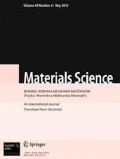Literature cited
K. MacMahon, K. Bryant, and S. Benerji, “The influence of hydrogen and impurities on the brittle fracture of steel,” in: Fracture Mechanics. News in Foreign Science [Russian translation], Mir, Moscow (1979), pp. 109–133.
J. C. Scully, “Mechanism of dissolution-controlled cracking,” Met. Sci.,12, No. 6, 290–300 (1978).
I. I. Vasilenko and R. K. Melekhov, Corrosion Cracking of Steels [in Russian], Nauk, Dumka, Kiev (1977).
C. Lea, “Stress corrosion cracking and temper brittleness effect of phosphorus grain boundary segregation in a low alloy steel,” Met. Sci., No. 3, 107–112 (1980).
P. Doig and P. E. J. Flewitt, “The influence of temper embrittlement on the stress corrosion susceptibility of Fe-3% Ni alloys,” Acta Met.,26, 1283–1291 (1978).
E. É. Glikman, R. É. Bruver, and K. Yu. Sarychev, “The influence of carbon on the intergranular internal adsorption and intergranular cohesion in Fe—P alloys,” Dokl. Akad. Nauk SSSR,200, No. 5, 1055–1058 (1971).
R. N. Parkins, “Stress corrosion cracking of low strength ferritic steels,” in: Theory of Stress Corrosion Cracking in Alloys, Brussels (1971), pp. 167–186.
J. Flis, “Effect of C on the corrosion of Fe in NH4,NO3 Sci. solution within a wide potential range,” Corros. Sci.,10, 745–759 (1970).
E. E. Glikman, Yu. V. Goryunov, V. M. Demin, and K. Yu. Sarychev, “The kinetics and mechanism of fracture of copper in deformation in surface-active molten substances,” Izv. Vyssh. Uchebn. Zaved., Fiz., No. 5, 7–15 (1976).
E. É. Glikman, “The change in carbon content in the zones near the grain boundaries in the development of temper brittleness of steel,” Fiz. Met. Metalloved., No. 4, 713–716 (1968).
J. Flis, “Action of carbon in stress corrosion cracking of mild steel in nitrate solutions,” Corrosion (USA),29, No. 1, 37–44 (1973).
G. V. Karpenko, I. I. Vasilenko, and N. I. Dikii, “The corrosion cracking of low-carbon steels in boiling nitrate solutions,” Dokl. Akad. Nauk SSSR,198, No. 6, 1393–1396 (1971).
S. V. Trubin, “An investigation of the low-temperature reversibility of intergranular impurity brittleness of certain bcc iron base solid solutions,” Author's Abstract of Candidate in Physicomathematical Sciences Thesis, Tomsk (1981).
Author information
Authors and Affiliations
Additional information
Translated from Fiziko-Khimicheskaya Mekhanika Materialov, Vol. 18, No. 5, pp. 26–31, September–October, 1982.
Rights and permissions
About this article
Cite this article
Glikman, E.É., Goryunov, Y.V., Ledovskaya, I.Y. et al. Influence of phosphorus impurity on the integranular corrosion cracking of iron and iron-carbon alloys in nitrates. Soviet Materials Science 18, 390–395 (1983). https://doi.org/10.1007/BF00770406
Received:
Issue Date:
DOI: https://doi.org/10.1007/BF00770406

